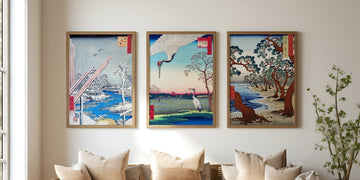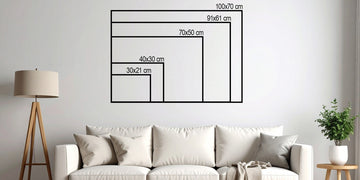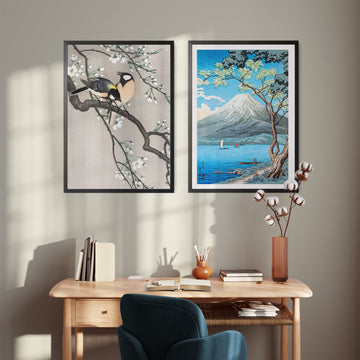Picture this: you walk into your home after a chaotic day of back-to-back Zoom calls, existential coffee shop debates, and trying to adult in general. Instead of being greeted by visual chaos that makes your brain go "NOPE," you're embraced by a space so peaceful it practically hands you a cup of tea and tells your stress to take a hike.
Welcome to the world of Japandi design - the aesthetic lovechild of Japanese minimalism and Scandinavian hygge that's been quietly revolutionizing how we think about tranquil homes. If you've ever wondered how some people's spaces look like they were designed by zen monks with impeccable taste (and somehow always stay clean), you're about to find out their secret.
Japandi design isn't just another Instagram-worthy trend that'll be forgotten faster than your New Year's resolutions. It's a thoughtful approach to creating minimalist decor that actually makes your daily life better, not just prettier. Think of it as Marie Kondo meets Nordic vibes, with a healthy dose of "less stuff, more peace" philosophy.
What Exactly Is Japandi Design, and Why Should I Care?
Japandi design is basically what happens when Japanese minimalism goes on a coffee date with Scandinavian design and they decide to move in together. The result? A design philosophy that prioritizes simplicity, functionality, and natural materials while creating spaces that feel like a warm hug from your most zen friend.
The core principles of Japandi design include
-
Minimalism with warmth - Less clutter, more coziness
-
Natural materials - Wood, bamboo, linen, and stone take center stage
-
Neutral color palettes - Think beiges, warm whites, soft grays, and muted earth tones
-
Functional beauty - Every item serves a purpose and looks good doing it
-
Connection to nature - Plants, natural light, and organic shapes bring the outdoors in
-
Quality over quantity - Fewer, better things that actually last

The beauty of Japandi design lies in its ability to create tranquil homes that don't feel sterile or boring. Unlike stark minimalism that can feel like living in a fancy hospital, Japandi spaces radiate warmth and invite you to actually, you know, live in them.
Why Is Everyone Obsessing Over Japandi Right Now?
Let's be honest - we're all a little overwhelmed these days. Between doomscrolling, productivity culture, and trying to figure out if we're supposed to be having hot girl summers or healing era winters, our brains need a break. Japandi design offers something our generation desperately craves: spaces that promote actual calm instead of just looking calm on social media.
Here's why Japandi is having a moment
- Digital detox vibes - Clean spaces help clear mental clutter
- Sustainability focus - Quality pieces over fast furniture appeals to eco-conscious millennials and Gen Z
- Work-from-home optimization - Creates productive, peaceful home offices
- Mental health awareness - Recognizes the connection between environment and well-being
- Instagram-worthy but livable - Looks great online but actually functions for real life

Plus, let's face it - maximalism is exhausting. Sometimes you just want to come home to a space that doesn't require you to process seventeen different patterns and forty-three decorative objects before you can relax.
How Do Japanese and Scandinavian Design Actually Work Together?
You might be wondering how two design philosophies from completely different corners of the world managed to blend so seamlessly. Plot twist: they have way more in common than you'd think.
Japanese design brings
- Wabi-sabi - Finding beauty in imperfection and impermanence
- Ma - The power of negative space and intentional emptiness
- Natural materials - Bamboo, wood, paper, and stone
- Craftsmanship focus - Attention to detail and quality construction
- Zen principles - Mindfulness and simplicity in daily living

Scandinavian design contributes
- Hygge - Cozy comfort and well-being
- Light woods - Birch, pine, and oak in warm, honey tones
- Textural warmth - Wool, linen, and other natural fabrics
- Functional design - Beautiful objects that serve real purposes
- Connection to nature - Despite harsh winters, bringing outdoors in
When these philosophies merge, you get spaces that are simultaneously minimal and cozy, functional and beautiful, serene and livable. It's like getting the best of both worlds without the commitment issues.
What Colors Create the Perfect Japandi Palette?
The Japandi color palette is basically what would happen if a sunset had a minimalist phase. We're talking warm, earthy tones that make you feel grounded without putting you to sleep.
Essential Japandi colors include
-
Warm whites - Cream, ivory, and off-white create a soft foundation
-
Soft beiges - From mushroom to sand, these add warmth without overwhelming
-
Muted grays - Gentle charcoal and dove gray provide subtle contrast
-
Natural wood tones - Honey, oak, and bamboo bring life and texture
-
Sage greens - Soft, muted greens that whisper rather than shout
-
Dusty blues - Barely-there blue-grays that feel like a calm sky
-
Earthy browns - Rich chocolates and warm taupes add depth

The key is choosing colors that feel like they could exist in nature—no neon pinks or electric blues here (save those for your workout clothes). Think "colors that wouldn't startle a deer" and you're on the right track. Read more about how colors impact your life in our other blogpost: Why Colors Matter: How Your Home's Color Palette Affects Your Daily Life
Which Materials Make a Space Feel Authentically Japandi?
Materials are where Japandi design really shines. This isn't about fake finishes or plastic pretending to be wood - we're talking about the real deal that ages beautifully and feels good to the touch.
Must-have Japandi materials
- Natural wood - Light oak, pine, birch, and bamboo in their natural glory
- Linen and cotton - Soft, breathable fabrics in neutral tones
- Wool - Chunky knits and smooth textures for warmth and coziness
- Stone and ceramics - Rough-hewn pottery and smooth river rocks
- Rattan and wicker - Bringing that natural, handcrafted feel
- Jute and hemp - Textural elements that ground the space
Materials to avoid
- Anything that screams "I'm trying too hard"
- Shiny metallics (unless it's brushed brass in tiny doses)
- Synthetic materials that feel plastic-y
- Overly processed or artificial-looking finishes
The goal is creating a space that feels like it grew organically rather than being assembled from a catalog. Each material should feel authentic and purposeful, not just decorative.
How Do I Start Creating a Tranquil Home with Japandi Design?
Ready to transform your space but don't know where to begin? The beauty of Japandi design is that you don't need to gut your entire home or spend your life savings. Start small and build mindfully—very on-brand for this aesthetic.
Step 1: Declutter with intention
- Keep only items that serve a purpose or bring genuine joy
- Store everything else out of sight in beautiful, functional containers
- Create breathing room between objects and furniture
Step 2: Choose a neutral foundation
- Paint walls in warm whites, soft beiges, or gentle grays
- Invest in quality neutral basics for large furniture pieces
- Let natural wood tones add warmth and texture
Step 3: Add natural elements
- Incorporate live plants (snake plants and pothos are practically foolproof)
- Choose furniture and decor made from natural materials
- Let in as much natural light as possible

Step 4: Focus on quality over quantity
- Buy fewer, better pieces that will last
- Choose items with clean lines and simple forms
- Prioritize functionality alongside beauty
What Are the Biggest Japandi Design Mistakes to Avoid?
Even with the best intentions, it's easy to accidentally create a space that feels more "sterile waiting room" than "tranquil sanctuary." Here are the pitfalls that trip up most Japandi beginners:
Common mistakes that kill the vibe
-
Going too stark - All white everything can feel cold and unwelcoming
-
Forgetting texture - Smooth surfaces need textural contrast to feel cozy
-
Skipping the plants - Natural elements are non-negotiable for authentic Japandi
-
Overdoing the minimalism - Your space should feel lived-in, not empty
-
Ignoring lighting - Harsh overhead lights destroy the peaceful atmosphere
-
Mixing too many wood tones - Stick to 2-3 complementary wood finishes max
-
Forgetting personal touches - Your space should reflect YOU, not a showroom
How to fix these mistakes
- Add soft textiles like linen throws and wool pillows
- Include warm lighting through table lamps and candles
- Display a few meaningful objects that spark joy
- Ensure every room has at least one living plant
- Layer different textures while staying within your color palette
How Can Wall Art Enhance My Japandi Space?
This is where things get exciting (and where our poster collection might just save your design game). Wall art in Japandi spaces isn't about making a statement - it's about creating quiet moments of beauty that enhance the overall tranquility.
Japandi wall art principles
- Simple, clean compositions - Think single botanical elements or abstract shapes
- Natural subjects - Plants, landscapes, stones, or organic forms
- Neutral or muted colors - Art should complement, not compete with, your palette
- Quality materials - Well-made prints on good paper or canvas
- Thoughtful placement - Less is more, with plenty of white space around each piece

Perfect Japandi art subjects
-
Botanical prints - Single leaves, branches, or minimalist plant studies
-
Abstract landscapes - Soft, muted scenes that suggest rather than detail
-
Geometric patterns - Simple shapes in natural colors
-
Typography - Meaningful quotes in clean, simple fonts
-
Photography - Black and white or sepia nature shots
The key is choosing pieces that make you pause and breathe a little deeper, not art that demands attention or starts conversations. Save the conversation starters for your personality - let your walls provide the calm backdrop.
Which Rooms Benefit Most from Japandi Design?
While Japandi principles work throughout your home, some spaces practically beg for this treatment. Here's where this design philosophy really shines:
The bedroom: Your personal retreat
- Soft, muted colors promote better sleep
- Minimal furniture reduces visual clutter
- Natural materials create a connection to nature
- Clean lines help your mind unwind
The home office: Productivity meets peace
- Clutter-free surfaces improve focus
- Natural materials reduce stress
- Neutral colors prevent visual fatigue
- Quality lighting supports long work sessions
The living room: Social zen
- Comfortable, minimalist furniture encourages conversation
- Natural elements create a welcoming atmosphere
- Clean lines make small spaces feel larger
- Neutral palette works with any season or occasion
The bathroom: Spa-like sanctuary
- Natural materials create a spa-like feel
- Minimal products reduce morning chaos
- Soft colors promote relaxation
- Quality towels and accessories feel luxurious
How Do I Maintain a Japandi Space Long-Term?
Creating a tranquil home is one thing - keeping it that way is another challenge entirely. The good news? Japandi design actually makes maintenance easier, not harder.

Daily maintenance habits
-
Put things back where they belong - Everything should have a designated home
-
Do a 10-minute tidy - Quick daily resets prevent clutter buildup
-
Dust and wipe surfaces - Clean lines show dirt more easily but clean up faster
-
Water your plants - Keep those natural elements thriving
-
Make your bed - Instant visual calm for minimal effort
Weekly maintenance routines
- Deep clean surfaces to maintain that fresh feeling
- Rotate or adjust art and decor to keep things interesting
- Assess what's not working and make small adjustments
- Bring in fresh flowers or rearrange plants
Monthly design check-ins
- Evaluate what items you haven't used or enjoyed
- Consider seasonal updates through textiles or small decor changes
- Assess whether your space still serves your current needs
- Plan any small improvements or additions
What's the Real Impact of Living in a Tranquil Home?
Beyond looking great on Instagram, Japandi design can genuinely improve your daily life. When your environment supports your well-being instead of working against it, everything else gets a little easier.
Benefits of tranquil home design
- Reduced stress and anxiety - Clean, organized spaces calm the nervous system
- Better sleep quality - Peaceful bedrooms actually help you rest better
- Increased productivity - Clutter-free workspaces improve focus and creativity
- Enhanced mindfulness - Thoughtful spaces encourage present-moment awareness
- Improved relationships - Welcoming spaces make hosting and connecting easier
- Greater life satisfaction - Your home becomes a source of joy rather than stress
The psychological impact: When you're surrounded by intentional, beautiful objects and clean lines, your brain doesn't have to work as hard to process your environment. This mental energy can then be redirected toward things that actually matter - your relationships, goals, and personal growth.
How Do I Make Japandi Work on Any Budget?
Here's the truth bomb: you don't need to spend a fortune to create a tranquil home. Japandi design is actually budget-friendly because it's about doing more with less, not buying expensive designer pieces.

Budget-friendly Japandi strategies
-
Start with what you have - Declutter and rearrange before buying anything new
-
DIY natural elements - Collect branches, stones, or dried flowers from nature
-
Shop secondhand - Vintage wood furniture often has perfect Japandi vibes
-
Invest in basics first - Good bedding, towels, and lighting make the biggest impact
-
Use plants as decor - Greenery is affordable and adds instant tranquility
-
Choose multipurpose items - Storage ottomans, folding screens, and modular furniture
Where to splurge vs. save
- Splurge on: Bedding, lighting, and a few key furniture pieces
- Save on: Decorative objects, seasonal items, and trendy accessories
Remember, Japandi is about quality over quantity. It's better to have one beautiful, well-made item than five mediocre ones that'll need replacing in a year.
Ready to Transform Your Space?
Creating a tranquil home with Japandi design isn't about perfection - it's about intention. Every choice you make, from the color of your walls to the art you display, should support the life you want to live and the person you want to be.
Start small, be patient with the process, and remember that the best Japandi spaces feel personal and lived-in, not like museum exhibits. Your home should tell your story, just in a calm, beautiful whisper rather than a chaotic shout.
The journey toward a more tranquil home begins with a single intentional choice. Maybe it's decluttering your nightstand, adding a plant to your workspace, or choosing wall art that makes you feel peaceful every time you see it. Whatever your first step, know that you're not just changing your decor - you're investing in your daily well-being and creating a foundation for a more mindful life.
Ready to bring Japandi tranquility to your walls? Explore our carefully curated collection of minimalist prints and Neutral Shapes both selected to complement any Japandi space and if you are looking for the monochrome look, check the Monochrome selection as well.














